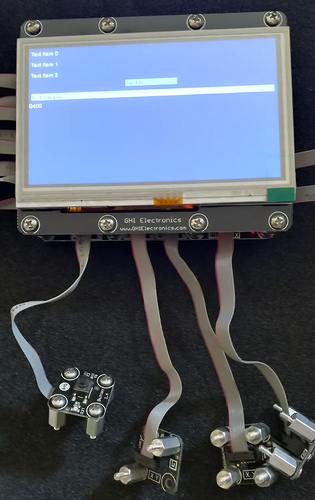@John_Brochue: for now, touch seems to be complicated to implement for me.
I try code below, but can’t see change control (maybe I don’t understand what right,left … behaviour is):
using System;
using System.Diagnostics;
using System.Runtime.InteropServices;
using G400UI.Properties;
using GHIElectronics.TinyCLR.Devices.Display;
using GHIElectronics.TinyCLR.Devices.Gpio.Provider;
using GHIElectronics.TinyCLR.Pins;
using GHIElectronics.TinyCLR.UI;
using GHIElectronics.TinyCLR.UI.Controls;
using GHIElectronics.TinyCLR.UI.Input;
using GHIElectronics.TinyCLR.UI.Media;
using ButtonEventHandler = Bauland.Gadgeteer.ButtonEventHandler;
// ReSharper disable UnusedMember.Global
namespace G400UI
{
class Program : Application
{
private static InputProvider _inputProvider;
private Program(DisplayController d) : base(d) { }
static void Main()
{
// Init button
Bauland.Gadgeteer.Button buttonLeft =
new Bauland.Gadgeteer.Button(FEZRaptor.GpioPin.Socket13.Pin3, FEZRaptor.GpioPin.Socket13.Pin4);
Bauland.Gadgeteer.Button buttonRight =
new Bauland.Gadgeteer.Button(FEZRaptor.GpioPin.Socket12.Pin3, FEZRaptor.GpioPin.Socket12.Pin4);
//Bauland.Gadgeteer.Button buttonUp =
// new Bauland.Gadgeteer.Button(FEZRaptor.GpioPin.Socket11.Pin3, FEZRaptor.GpioPin.Socket11.Pin4);
Bauland.Gadgeteer.Button buttonDown =
new Bauland.Gadgeteer.Button(FEZRaptor.GpioPin.Socket10.Pin3, FEZRaptor.GpioPin.Socket10.Pin4);
var version = new Version(DeviceInformation.Version);
string info = "Device: " + DeviceInformation.DeviceName + " - " + version;
Debug.WriteLine(info);
var displayController = DisplayController.GetDefault();
// Enter the proper display configurations
displayController.ApplySettings(new ParallelDisplayControllerSettings
{
Width = 480,
Height = 272,
PixelClockRate = 20 * 1000 * 1000,
PixelPolarity = false,
OutputEnablePolarity = true,
OutputEnableIsFixed = false,
HorizontalFrontPorch = 2,
HorizontalBackPorch = 2,
HorizontalSyncPulseWidth = 41,
HorizontalSyncPolarity = false,
VerticalFrontPorch = 2,
VerticalBackPorch = 2,
VerticalSyncPulseWidth = 10,
VerticalSyncPolarity = false
});
var app = new Program(displayController);
_inputProvider = app.InputProvider;
buttonLeft.Pressed += Btn_Left_Pressed;
buttonLeft.Released += Btn_Left_Released;
buttonRight.Pressed += Btn_Right_Pressed;
buttonRight.Released += Btn_Right_Released;
//buttonUp.Pressed += Btn_Up_Pressed;
//buttonUp.Released += Btn_Up_Released;
buttonDown.Pressed += Btn_Down_Pressed;
buttonDown.Released += Btn_Down_Released;
app.Run(CreateWindow(displayController));
//// Some needed objects
//var screen = Graphics.FromHdc(displayController.Hdc);
//// Start Drawing (to memroy)
//screen.Clear(Color.Black);
//var brush = new SolidBrush(Color.Green);
//var font = Resources.GetFont(Resources.FontResources.NinaB);
//screen.DrawString(info, font, brush, 20, 20);
//// Flush the memory to the display. This is a very fast operation.
//screen.Flush();
}
private static void Btn_Left_Released(object sender, Bauland.Gadgeteer.ButtonEventHandlerArgs args)
{
_inputProvider.RaiseButton(HardwareButton.Left, false, DateTime.UtcNow);
}
private static void Btn_Left_Pressed(object sender, Bauland.Gadgeteer.ButtonEventHandlerArgs args)
{
_inputProvider.RaiseButton(HardwareButton.Left, true, DateTime.UtcNow);
}
private static void Btn_Right_Released(object sender, Bauland.Gadgeteer.ButtonEventHandlerArgs args)
{
_inputProvider.RaiseButton(HardwareButton.Right, false, DateTime.UtcNow);
}
private static void Btn_Right_Pressed(object sender, Bauland.Gadgeteer.ButtonEventHandlerArgs args)
{
_inputProvider.RaiseButton(HardwareButton.Right, true, DateTime.UtcNow);
}
private static void Btn_Up_Released(object sender, Bauland.Gadgeteer.ButtonEventHandlerArgs args)
{
_inputProvider.RaiseButton(HardwareButton.Up, false, DateTime.UtcNow);
}
private static void Btn_Up_Pressed(object sender, Bauland.Gadgeteer.ButtonEventHandlerArgs args)
{
_inputProvider.RaiseButton(HardwareButton.Up, true, DateTime.UtcNow);
}
private static void Btn_Down_Released(object sender, Bauland.Gadgeteer.ButtonEventHandlerArgs args)
{
_inputProvider.RaiseButton(HardwareButton.Down, false, DateTime.UtcNow);
}
private static void Btn_Down_Pressed(object sender, Bauland.Gadgeteer.ButtonEventHandlerArgs args)
{
_inputProvider.RaiseButton(HardwareButton.Down, true, DateTime.UtcNow);
}
private static Window CreateWindow(DisplayController displayController)
{
var window = new Window
{
Height = (int)displayController.ActiveSettings.Height,
Width = (int)displayController.ActiveSettings.Width
};
window.Background = new SolidColorBrush(Color.FromRgb(0, 0, 64));
var font = Resources.GetFont(Resources.FontResources.small);
OnScreenKeyboard.Font = font;
//List
var listBox = new ListBox { Child = { Width = window.Width } };
//Text
for (var i = 0; i < 3; i++)
{
var text = new Text(font, $"Text item {i}");
text.SetMargin(5);
text.ForeColor = Colors.Yellow;
listBox.Items.Add(text);
}
//Button
var j = 0;
var val = new Text(font, "Tap Me");
var btn = new Button
{
Child = val,
Width = 100
};
btn.SetMargin(5);
btn.Click += (s, e) => val.TextContent = "Tap Me " + (j++).ToString();
listBox.Items.Add(btn);
//Textbox
var txt = new TextBox
{
Font = font,
Text = "Text Sample"
};
txt.SetMargin(5);
listBox.Items.Add(txt);
// Text
var label = new Text
{
Font = font,
TextContent = DeviceInformation.DeviceName,
ForeColor = Colors.Yellow
};
listBox.Items.Add(label);
//Setup
window.Child = listBox;
window.Visibility = Visibility.Visible;
return window;
}
}
public class Version
{
private int Major { get; }
private int Minor { get; }
private int Patch { get; }
private int Build { get; }
public Version(ulong version)
{
Major = (int)((version >> 48) & 0x000000000000ffff);
Minor = (int)((version >> 32) & 0x000000000000ffff);
Patch = (int)((version >> 16) & 0x000000000000ffff);
Build = (int)((version >> 00) & 0x000000000000ffff);
}
public override string ToString()
{
return Major + "." + Minor + "." + Patch + "." + Build;
}
}
}
 but we are providing TinyCLR to almost all devices we have ever shipped. Go ahead and try it today.
but we are providing TinyCLR to almost all devices we have ever shipped. Go ahead and try it today.
